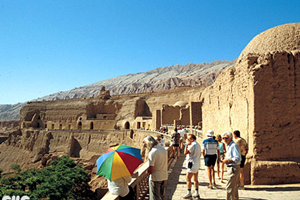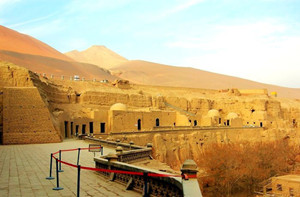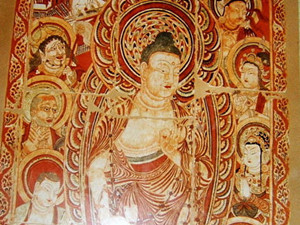Home > Attractions >
The Bezeklik Thousand Buddha Caves
As one of the four major grottoes on silk road tour destinations of China, Bezeklik Thousand Buddha Caves is located on the west bank of Murtuq River Huoyanshan Valley about 40 kilometers east of downtown Turpan, Xinjiang Uygur Autonomous Region.
Introduction of Bezeklik Thousand Buddha Caves
Bezeklik means halfway of the mountain in Uighur language. The grottoes are scattered on a cliff within about one kilometer on the west bank of the river valley, including three levels.
The grottoes was excavated in the late Northern and Southern Dynasties. It has been one of the Buddhist centres in the Western Regions through the Tang, Five Dynasties, Song and Yuan Dynasties. Though they pale in comparison to the cave art of Dunhuang it's still possible to sense the importance of Buddhism to Silk Road travelers, many of whom stopped here to pray for a successful journey. Most of the relics here were carted off by German explorer Albert Von Le Qoc and subsequently destroyed in the Allied bombing of Berlin. Dug into a mountain side beneath sweeping sand dunes and overlooking a roaring stream, the location is beautiful and haunting. the site is quite worth to visit, even if you don't go into the actual caves.
What to visit in Bezeklik Thousand Buddha Caves?
There are 83 caves, of which over 40 have murals with total preserved area of 1,200 square metres, among them the murals in Cave 20 depict the images of the King and the Queen of Gaochang.
Cave 33 shows the intention of shows the intention of the disciples of Fnirvana to mourn in silence, while Cave 38 reflected the life scene of ancient Manichaeism. Grottoes 82 and 83 are small commemorative Grottoes specially built for Buddhist monks during the Gaochang period.
When is the best time to visit?
Every March to September are the best time to travel to Turpan. However, from June to July is the hottest time in Turpan, the temperature will be above 40 degrees. In addition, the Turpan Grape Festival will be held in August, at that time, tourists can taste the grapes and enjoy the various of traditional Uighur activities and performances, such as Dawazi performance, Mukam folk songs and dances and so on. In September, the weather is moderately cool, during that time, the pleasant smell of fruit is spreading everywhere, which is quite worth to visit.
The historic information of Bezeklik Thousand Buddha Caves:
Gaochang is the most prosperous period of the grottoes, at the end of the 13th century, the Gaochang royal family moved eastward to Yongchang, Gansu Province. With the introduction of Islam into Turpan and the influence of Buddhism was declined, so at that time, the Thousand Buddha Caves was destroyed in the pagan conflict, and the eyes of murals were all removed. At the beginning of this century, they were repeatedly robbed and destroyed by foreigners, which made the situation worse. However, the remaining Buddha seats and murals quite are gorgeous and exquisite, so these historical relics are still a huge treasure house of culture and art.
Travel tips of Bezeklik Thousand Buddha Caves:
1.Bezeklik Thousand Buddha Caves is situated on the hillside, please do not visit the unopened area.
2.Tourists are not allowed to take pictures in the Thousand Buddha Caves.
3. Tourists are not allowed to touch murals and smoke in caves, etc.
The ticket price of Scenic Area: 40 RMB/Person
Opening Time:
Peak season: 21st April to 20th October ( 8.00 AM to 8.00 PM )
Off season: 21st October to 20th April ( 10.00 AM to 6.30 PM )
Introduction of Bezeklik Thousand Buddha Caves
Bezeklik means halfway of the mountain in Uighur language. The grottoes are scattered on a cliff within about one kilometer on the west bank of the river valley, including three levels.
The grottoes was excavated in the late Northern and Southern Dynasties. It has been one of the Buddhist centres in the Western Regions through the Tang, Five Dynasties, Song and Yuan Dynasties. Though they pale in comparison to the cave art of Dunhuang it's still possible to sense the importance of Buddhism to Silk Road travelers, many of whom stopped here to pray for a successful journey. Most of the relics here were carted off by German explorer Albert Von Le Qoc and subsequently destroyed in the Allied bombing of Berlin. Dug into a mountain side beneath sweeping sand dunes and overlooking a roaring stream, the location is beautiful and haunting. the site is quite worth to visit, even if you don't go into the actual caves.
What to visit in Bezeklik Thousand Buddha Caves?
There are 83 caves, of which over 40 have murals with total preserved area of 1,200 square metres, among them the murals in Cave 20 depict the images of the King and the Queen of Gaochang.
Cave 33 shows the intention of shows the intention of the disciples of Fnirvana to mourn in silence, while Cave 38 reflected the life scene of ancient Manichaeism. Grottoes 82 and 83 are small commemorative Grottoes specially built for Buddhist monks during the Gaochang period.
When is the best time to visit?
Every March to September are the best time to travel to Turpan. However, from June to July is the hottest time in Turpan, the temperature will be above 40 degrees. In addition, the Turpan Grape Festival will be held in August, at that time, tourists can taste the grapes and enjoy the various of traditional Uighur activities and performances, such as Dawazi performance, Mukam folk songs and dances and so on. In September, the weather is moderately cool, during that time, the pleasant smell of fruit is spreading everywhere, which is quite worth to visit.
The historic information of Bezeklik Thousand Buddha Caves:
Gaochang is the most prosperous period of the grottoes, at the end of the 13th century, the Gaochang royal family moved eastward to Yongchang, Gansu Province. With the introduction of Islam into Turpan and the influence of Buddhism was declined, so at that time, the Thousand Buddha Caves was destroyed in the pagan conflict, and the eyes of murals were all removed. At the beginning of this century, they were repeatedly robbed and destroyed by foreigners, which made the situation worse. However, the remaining Buddha seats and murals quite are gorgeous and exquisite, so these historical relics are still a huge treasure house of culture and art.
Travel tips of Bezeklik Thousand Buddha Caves:
1.Bezeklik Thousand Buddha Caves is situated on the hillside, please do not visit the unopened area.
2.Tourists are not allowed to take pictures in the Thousand Buddha Caves.
3. Tourists are not allowed to touch murals and smoke in caves, etc.
The ticket price of Scenic Area: 40 RMB/Person
Opening Time:
Peak season: 21st April to 20th October ( 8.00 AM to 8.00 PM )
Off season: 21st October to 20th April ( 10.00 AM to 6.30 PM )






